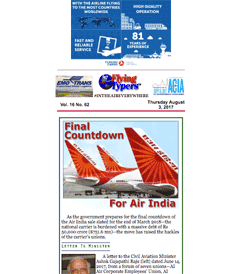

#INTHEAIREVERYWHERE
 |
 #INTHEAIREVERYWHERE |
| Vol. 16 No. 65 | Tuesday August 15, 2017 |
Euro Shippers Overview For Summer 2017 |
Same Old Song “What shippers are looking for is something we’ve been talking about for years,” he explained. “The major win for air freight is the time it takes to get goods from A to B. But airfreight often takes six days’ door-to-door to the U.S. or Europe from Asia even though the flight is two days, tops. That means cargo is standing still for far too long, waiting to be picked up and cleared. That process needs speeding up. This is why at the moment shippers only use air freight out of necessity for critical shipments, not as an integral part of their supply chain planning.”
Transparency Needed Many of the delays are due to a lack of supply chain transparency that prevents timely pick-up post-customs clearance at the destination airport. “There needs to be a more analytical process so shippers know how long it will take goods to pass through customs, security, and inspection and can plan the pick-up,” he said. “They want to know when exactly they can expect their freight.”
Pathways to Contact A reliance on traditional forms of communication also compounds delays. “Air freight communication systems are often very old,” he said. “There is too much paper in the system, which is very much open for errors and mistakes. We already have the capability to do a lot more digitally using datasets and exchanging data to get a closed data stream that would help with transparency so you know where freight is. This is very important for temperature-controlled cargoes such as pharma and foodstuffs, but also reduces the administrative burden and speeds clearance at customs.”
Strategies To New Markets Mr. Spoel believes changes in how major shippers strategize future supply chain plans will open up new markets and trade flows to air freight stakeholders—but only if they can adapt to the new demands. “Shippers want more predictability in the supply chain,” he said. “Big multinationals have distribution centers throughout Europe. They import goods that are then moved to DCs and from there they supply shops and customers. If they can cut down DCs, which are expensive, they can make huge savings. But to do that they need a floating warehouse, so their inventory is mobile. They need to be able to rely on air and ocean for this.“For example, at the moment a big fashion company producing shirts in China ships them to a European DC and then supplies customers and shops through ecommerce. But really, they want to go direct to the shop and customer rather than via their DC. That’s the long-term vision. They’ll still need a DC, but they can cut its size and cost. First, they need that service from the air freight industry so they control the logistics flow of goods accurately.” Stumbling Processes Mr. Spoel said cargo
consolidation processes were often the biggest stumbling block, not
least because cargo often disappeared into internal LSP systems during
the crucial period before the flight, removing transparency for the
shipper. “Consolidation is how logistics service providers offer
lower prices and that’s the selling point,” he explained.
“But there seems to be a misconception that creating transparency
will kill the golden goose. As a shipper we don’t want to know
everything the LSP does, but they are protective of what they do.
Case In Point
He said an April workshop organized with telecommunications giant
Ericsson, a member of TIACA, revealed some key findings that could
illustrate to air freight service providers exactly what customers
want—an air cargo data pipeline. |
If
You Missed Any Of The Previous 3 Issues Of FlyingTypers Access complete issue by clicking on issue icon or Access specific articles by clicking on article title |
||
 Vol. 16 No. 62 Final Countdown For Air India Chuckles for August 2, 2017 Modern Air Cargo Took Off From Frankfurt USACIA Must Attend Event |
 Vol.
16 No. 63 Vol.
16 No. 63India Taking Air Cargo Personal Chuckles For August 8, 2017 Cargo Affairs From The Heart Dimerco Upward Beat Goes On Quote Of The Week |
|
Publisher-Geoffrey
Arend • Managing Editor-Flossie Arend • Film Editor-Ralph Arend • Special Assignments-Sabiha Arend, Emily Arend • Advertising Sales-Judy Miller |
|